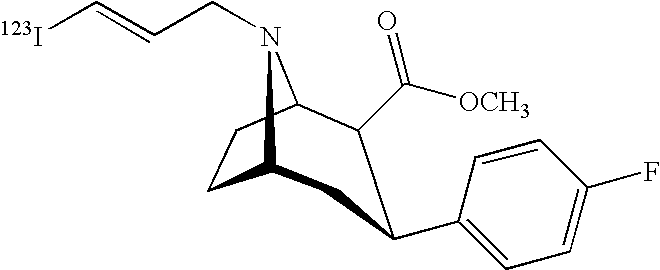Labeled iodinated tropane formulation
a technology of iodinated tropane and formulation, applied in the field of medicine, can solve the problems of high misdiagnosis rate, no available test that can clearly identify parkinson's syndrome, and 50% misdiagnosis
- Summary
- Abstract
- Description
- Claims
- Application Information
AI Technical Summary
Benefits of technology
Problems solved by technology
Method used
Image
Examples
example 1
Synthesis of [123I]-2β-carbomethoxy-3β-(4-flurophenyl)-N-(3-iodo-E-allyl) nortropane
[0047]Sodium [123I]-iodide (4 Ci) in 0.1N NaOH was dispensed in a 10 mL vial and heated to about 80° C. Phosphate buffer, 0.80 mL 0.1 M, pH 2.5-3.0, was combined with 0.20 mL 30% hydrogen peroxide, and 0.50 mL of 1 mg / mL (in ethanol) 2β-Carbomethoxy-3β-(4-fluorophenyl)-N-(3-tributyltin-E-allyl) nortropane) to form a precursor containing mixture. The sodium [123I]-iodide solution was acidified (final pH 123I]-iodide solution. The mixture was heated at 80° C. for 15 minutes.
[0048]After 15 minutes, 2 mL of sodium metabisulfite solution was added to stop the reaction (100 mg / mL in Sterile Water for Injection). One mL of a 100 mg / mL solution of Ascorbic Acid was added to the reaction mixture as a radioprotectant. The acidic reaction mixture is optionally neutralized with 500 μL of 5 N Sodium Hydroxide. After neutralization, the pH is >6. Neutralization may be optional if the subsequent HPLC system is not ...
example 2
Chromatography of [123I]-2β-carbomethoxy-3β-(4-flurophenyl)-N-(3-iodo-E-allyl) nortropane
[0049]The reaction mixture of Example 1 was transferred to a preparative HPLC system (XTerra® C18 Column from Waters Corp., Milford, Mass., see U.S. Pat. No. 6,686,035).
XTerra ® columnPacking Material:C-18Particle Size: 5 μmLength:50 mmDiameter:10 mmColumn Volume: 4 mL
[0050][123I]-2β-carbomethoxy-3β-(4-flurophenyl)-N-(3-iodo-E-allyl) nortropane was eluted using the following eluent system: isocratic elution buffer, 15% (v / v) ethanol, 85% 10 mM glacial acetic acid in sterile water for injection. The product peak was collected into a vessel containing sodium chloride injection (USP) in an acetic acid buffer pH 2.5 to 3.5, and, due to carry over, the final solution has about 1.8% ethanol. Noted is the fact that in particular embodiments, the product comprises an aqueous solution comprising 0.1-5 mCi / mL, at the time of production, [123I]-2β-carbomethoxy-3β-(4-flurophenyl)-N-(3-iodo-E-allyl) nortropa...
example 3
Chromatography of [123I]-2β-carbomethoxy-3β-(4-flurophenyl)-N-(3-iodo-E-allyl) nortropane
[0052]The reaction mixture of Example 1 was transferred to a preparative HPLC system (μBondpak® C18 Column from Waters Corp., Milford, Mass.).
μBondpak columnPacking Material:C-18Particle Size: 10 μmLength:300 mmDiameter: 19 mmColumn Volume: 85 mL
[0053][123I]-2β-carbomethoxy-3β-(4-flurophenyl)-N-(3-iodo-E-allyl) nortropane was eluted using the following eluent system: isocratic elution buffer, 80% (v / v) ethanol, 20% ascorbic acid in sterile water for injection 20 g / L. The product peak was collected into a vessel containing sodium chloride injection (USP) in an acetic acid buffer pH 2.5 to 3.5. Due to carry over the final solution has about 3.8 to about 6.3% ethanol and about 0.2 to about 0.4 g / L ascorbic acid. The resulting radioactive concentration of [123I]-2β-carbomethoxy-3β-(4-flurophenyl)-N-(3-iodo-E-allyl) nortropane was about 5 mCi / mL of solution.
PUM
| Property | Measurement | Unit |
|---|---|---|
| temperature | aaaaa | aaaaa |
| v/v | aaaaa | aaaaa |
| half life | aaaaa | aaaaa |
Abstract
Description
Claims
Application Information
 Login to View More
Login to View More - R&D
- Intellectual Property
- Life Sciences
- Materials
- Tech Scout
- Unparalleled Data Quality
- Higher Quality Content
- 60% Fewer Hallucinations
Browse by: Latest US Patents, China's latest patents, Technical Efficacy Thesaurus, Application Domain, Technology Topic, Popular Technical Reports.
© 2025 PatSnap. All rights reserved.Legal|Privacy policy|Modern Slavery Act Transparency Statement|Sitemap|About US| Contact US: help@patsnap.com

